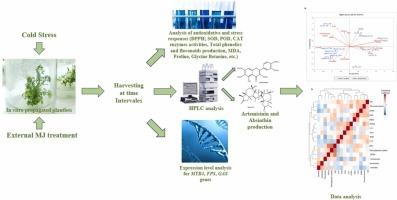外源茉莉酸甲酯和低温对苦艾离体繁殖植株青蒿素和苦艾素产量的影响
IF 6.2
1区 农林科学
Q1 AGRICULTURAL ENGINEERING
引用次数: 0
摘要
倍半萜内酯是菊科植物主要的次生代谢产物,具有多种生物活性。青蒿素是青蒿属中最著名的倍半萜内酯,已被证明具有抗疟疾和抗癌活性。除青蒿素外,苦艾草(Artemisia absinthium L.)还产生苦艾素(absinthin)作为主要的苦倍半萜内酯。本文研究了外源茉莉酸甲酯(methyl jasmonate, MJ)对苦艾离体繁殖植株冷胁迫生理反应和次生代谢产物产生的影响。将两个月大的体外萌发苦艾草幼苗分别暴露在4和10 °C的温度下,并在0、8、24和48 h的时间内分别添加和不添加MJ(25 μM)。采用高效液相色谱法测定青蒿素和苦艾素含量,采用实时荧光定量pcr法测定倍半萜内酯生物合成基因、法尼基焦磷酸合成酶(FPPS)和革蕊烯A合成酶(GAS)以及MYB4转录因子的转录水平。结果显示过氧化氢(H2O2)水平增加,表明氧化应激。同时,过氧化氢酶(CAT)、超氧化物歧化酶(SOD)、过氧化物酶(POX)等抗氧化酶活性升高。此外,相容溶质甘氨酸甜菜碱(GB)的水平也有所增加。FPPS表达水平与MYB4和GAS表达水平呈显著正相关。然而,MYB4的表达水平与GAS之间没有直接的相关性。总体而言,外源MJ降低了冷胁迫对苦艾植株的不利影响。本文章由计算机程序翻译,如有差异,请以英文原文为准。

Artemisinin and absinthin production in response to exogenous methyl jasmonate and chilling in Artemisia absinthium L. in vitro propagated plantlets
Sesquiterpene lactones with diverse biological activities are predominant secondary metabolites in the Asteraceae family. Artemisinin is the best-known sesquiterpene lactone in the genus Artemisia which, has proved to have antimalarial and anticancer activities. In addition to artemisinin, Artemisia absinthium L. produces absinthin as the main bitter sesquiterpene lactone. Here, the effects of exogenous methyl jasmonate (MJ) on cold stress responses of A. absinthium in vitro propagated plantlets in terms of physiological responses and secondary metabolites production have been investigated. Two-month-old in vitro germinated A. absinthium plantlets were exposed to 4 and 10 °C temperatures with and without MJ (25 μM) during 0, 8, 24, and 48 h time courses. Artemisinin and absinthin contents have been measured by HPLC and the transcript levels of sesquiterpene lactones biosynthetic genes, farnesyl pyrophosphate synthase (FPPS), and germacrene A synthase (GAS), as well as the MYB4 transcription factor were estimated by real-time qRT-PCR in treated plantlets. Results showed an increase in the levels of hydrogen peroxide (H2O2), indicating oxidative stress. Along with this, the activity of antioxidant enzymes, including catalase (CAT), superoxide dismutase (SOD), and peroxidase (POX) was elevated. Additionally, the levels of glycine betaine (GB), a compatible solute, were also increased. Significant positive correlations were observed between FPPS expression and the expression levels of MYB4 and GAS. However, no direct correlation was found between the expression levels of MYB4 and GAS. Overall, exogenous MJ reduced the adverse effects of cold stress on A. absinthium plantlets.
求助全文
通过发布文献求助,成功后即可免费获取论文全文。
去求助
来源期刊

Industrial Crops and Products
农林科学-农业工程
CiteScore
9.50
自引率
8.50%
发文量
1518
审稿时长
43 days
期刊介绍:
Industrial Crops and Products is an International Journal publishing academic and industrial research on industrial (defined as non-food/non-feed) crops and products. Papers concern both crop-oriented and bio-based materials from crops-oriented research, and should be of interest to an international audience, hypothesis driven, and where comparisons are made statistics performed.
 求助内容:
求助内容: 应助结果提醒方式:
应助结果提醒方式:


